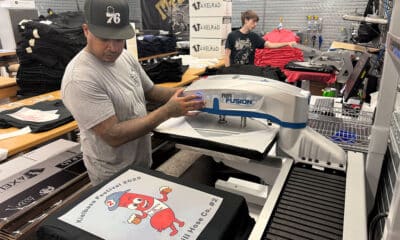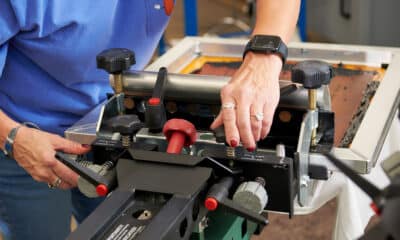I HAVE MORE THAN 25 years working in the apparel decorating business, and I’ve seen a lot of challenges come and go. I’ve also heard my share of horror stories from other decorators from hanging out in trade shows, classes, seminars, webinars, and trolling the various Internet forums over the years. Below is a list of the “20 Biggest Mistakes” that I’ve heard of, and a comment or two on how you can avoid them. These aren’t ranked — I’m writing them as I remember them.
1. Not being honest. Seriously, this is the biggest mistake you can make, and I know I said I wasn’t going to rank these…but this would be No.1 if I did. In any business you must be honest with people. Your clients, your employees, your vendors…everyone. Once you start stretching the truth, it’s hard to get that genie back in the bottle. Believe it or not, there are people that I know in this industry that are less than honest (you know who you are…) and feel it’s acceptable to conduct business this way.
If you run your business and cover up your challenges (missed ship dates, art issues, inventory counts, shirt defects, employee pay, freight tracking, etc.) with small lies, it’s not too late to stop. Sooner or later those small lies come out too easily, and larger lies start surfacing too. Then word gets out, and everyone knows… Instead, just accept the fact that mistakes happen, things don’t go your way, and be truthful about the situation. Own up to your shortcomings and do whatever you need to make it right. It will be OK.
2. Not documenting your inventory. Whether you are purchasing your own stock, or your customers send it in. Your receiving team must be 100% accurate with their counts and verify everything as quick as they possibly can. Accuracy is key, but speed also is a factor as any discrepancies should be reported as soon as possible for resolution.
If possible, get your vendors or customers to send in packing lists with the goods and check against that. Everything must be counted and checked in by your team. Don’t take anyone’s word for it — if anything comes up “missing,” you may have to purchase the deficit to complete the order. It’s just a better practice to count everything — no matter what — and verify you have what you need. Otherwise, this could be a very expensive problem.
3. Hourly employees clocking in late. Before I instituted a tardiness program, I had an employee that would clock in late all the time. His cavalier attitude made me wonder how much time he really was late. I had his timesheets pulled for a three-month period and he was late a cumulative amount of more than 40 hours! Build a policy, make it fair, put it in your handbook, and stick to it.
4. Hourly employees clocking in whenever they want. This relates to the above point. Overtime is not a right and should be approved in advance. Just because someone “wants” to work late doesn’t necessarily mean that this is really needed. Especially if other members of the same department aren’t getting their full 40 hours. Make a schedule and divide up the work. Stress teamwork. If you are super busy and extra time in a project is warranted, then overtime is OK of course. Keep track of everyone’s hours with a spreadsheet or other reporting tool.
5. Agreeing to work you can’t do. Salespeople are notorious for this the world over, and this probably will never change. They will sell a job — the particulars don’t really matter for this example — that is beyond the capabilities of the shop to produce. Then it gets dumped in the production department’s lap with the instructions, “Just make it work.”
Hopefully your shop has a production schedule that’s easily understood by everyone, with comprehension on what can be booked and added to the schedule. What are the technical limitations of the shop? How much can you possibly print or embroider in one shift? What are the costs of overtime? Do yourself a favor and track the actual costs of some of these gems and compare to what was charged. Are you still making money?
6. Putting up with “Deadwood Fred.” Many shops have someone like this — you know this guy. He has a lazy attitude but sometimes has flashes of real skill, so management puts up with him. He’s a morale killer, and your floor managers talk about him at least once a week. Nobody has written him up or disciplined him, so HR says if you terminate him, it could cost the company money.
This is why a robust performance review program will either get Fred to be a solid performer, or if he doesn’t improve either drive him to self-terminate or build enough documentation on his unprofessional work performance that you can defend your decision in court if need be. Make sure your managers are documenting and disciplining him for any challenge as it comes up. I’ve always believed that if you must terminate someone for performance issues it shouldn’t be a surprise to the employee.
7. Ink don’t think. Not very grammatically correct on purpose, but before you start blaming the ink you are using look at all the mechanical processes that go before it. It may be the ink, but it may also be the art, the screens, the press, the print set up, squeegees, your people…really any number of things. Volumes of books have been written on the proper ways to screen print, so I’m not going to get bogged down in them here. But let’s just say that you need to rule out some things first. Lastly, and very contradictory, maybe it is your ink. At least that’s what the other sales rep says.
8. Know your market. In just about every T-shirt shop across the country, someone comes in about once a week with the “GREATEST T-SHIRT IDEA EVER.” Very few succeed in developing their idea and bringing it to market. Why? They just don’t understand it and are lazy. Pick any day and read comments and questions left by these people on social sites about T-shirts and you’ll see the same refrain. The successful start-ups all do the homework. They have a written business plan. They understand their market, their competition, how to sell, and at what price. They go in conservatively and usually with pre-sold inventory, which reduces their out-of-pocket expenses. T-shirt shops really don’t care — it’s a sale. Get that cash up front though.
Lack of training. When I visit shops, two things immediately stand out. Shops that are organized and have a well-trained staff hum like a well-oiled machine. These shops have a cross-training program and deploy people as needed. Is the press operator sick? No problem. There’s three or four people that can fill in for him.
On the other hand, shops that highly are segmented and have the mentality that certain staff members are pigeon-holed in their jobs. Or worse, the production management is too lazy or undisciplined to build a training program are rife with problems. People don’t know what to do and must always be “told.” The shop runs like a dictatorship. These shops have an apathy and morale problem, usually more overtime, and a higher defect rate than most.
9. Lack of Organization. Running a shop by the seat of your pants can work for some folks, but there are probably times where this method becomes a big challenge. Thoughtful, organized and creative managers know that eliminating clutter, putting the tools next to the work, and planning every single aspect gets them to their goals faster, cheaper, and better than just using the “cross your fingers and pray” method. If you must have a daily production meeting with your production and sales staff to sort out what’s going to be produced today, you aren’t doing it right. Be disciplined in your approach and have high levels of communication that everyone in the shop can understand.
10. Not understanding cost control. Larger shops understand the benefit of keeping a tight rein on material costs. I hear this all the time as smaller shops complain that they can’t understand how a larger shop can undercut their price by such a large margin and still make money. Chances are that they could be making even more of a percentage profit, as the larger shops filter through more work through their shop and have standardized and automated a lot of the processes.
Better-run shops also do their homework and analyze everything. While one shop may purchase their ink in one-gallon buckets, more forward-thinking ones won’t think anything of bringing in a 30- or 50-gallon drum of the same ink (usually white or black ink), as they know that they’ll use this ink up over the course of a year.
While a smaller shop can waiver on whether or not to purchase some new equipment, more aggressive and smart shops do the math and determine the ROI of purchasing the equipment as they can calculate the reduction in material, labor, energy or other factors for their shop. It isn’t a “gut decision,” but one proved with math, which makes it easy. Also, shop owners that understand the value in building better margins also understand the value in building a sustainability program. Sure, it’s good for the environment and your karma to be green — but the main business value-add is toward your bottom line.
11. Lack of Communication. This is crucial. When I meet other businesspeople in a social setting — chamber of commerce breakfasts, after-hours events, or receptions at tradeshows — one of my favorite icebreaker questions I ask is, “What is your biggest problem that you work on daily?” I ask this question to everyone, even people outside the apparel decoration industry. The most common response is lack of communication. This can be internally with your staff or externally in dealing with your customers.
How are you handling this common problem? Do you have a disciplined approach to taking orders such as purchase orders or forms that must be filled out? Or do you shoot from the hip and an e-mail is good enough? Do you send out art approval forms and have the client approve the art before anything gets produced? Do you have all the notes, instructions and anything that can make the production for the order go smoother in your system, on the work order, and available for your staff to read?
If production must stop to go ask someone a question before running the order, you aren’t doing this right. An extra three-to-five minutes by your sales or customer service staff in adding more detail to your order can save someone in the back shop up to an hour in production time. You must insist that this communication happens and constantly train on it with your staff.
12. Safety. I’ve been in many T-shirt production shops over the years. Some are surgical operating room clean, with everything neat, orderly and ready to work. Some look like a tsunami just hit. Some are in between. The apparel industry in general is prone to safety challenges if not managed correctly. About once a year, you read online about a shop that went up in flames, or someone was seriously hurt, because a staff member wasn’t paying attention.
This is 1000% a management challenge. It doesn’t take much for some hanging lint to catch fire, a can of spray tack to go down the dryer and explode, the forklift driver to run over somebody, or someone to get whacked by a rotating platen on an automatic press. These things can happen in an instant. Are you ready?
Better yet, what are you doing to prevent these accidents from happening in the first place? When was the last time you had a fire drill at your shop? What about fire extinguisher training? Do you have written policies and procedures? Do you even know what PPE’s (Personal Protection Equipment such as safety goggles, gloves, or earplugs) are and how to use them? Do you have a training program?
13. Lack of Strategic Planning. Many shops are reactive. Meaning they just sit there and wait for the business to come to them or wait until they need or are forced to do something to alter their thinking. Why wait? Like a chess game, the shops that have a leadership mentality are usually the ones that are ahead of the curve and take a proactive stance on everything. They think three moves ahead. They research and constantly are looking for an edge.
This could be in how they market their shop and attract new business. It also could be how they look at decorating by adding new techniques or experimenting with developing new revenue streams that are different than their core business. Strategic planning is innovating and constantly changing their business to suit what’s going on in the real world. They take advantage of opportunities.
For example, it’s no surprise that digitally printing a shirt is growing in popularity, speed, and techniques. Eventually, this could surpass traditional screen printing for a lot of shops. Where are you on this topic have you done any research at all? How will you adapt to changes in your market sector? What are you innovating?
14. Being prepared to work. What I’m referring to here is how your shop is laid out, and how you are prepped to get more work through your shop on a daily basis. In many shops I’ve seen, the press crews have to go looking for stuff — the next order, a new squeegee, their ink, screens or even the shirts to print. You should have the next job ready to go, with the work order, shirts, inks and screens available. I call this “kit-packing.”
Management’s role in this is to determine ways to make it easier for the staff to work. You should have duplicate tools at every press. If you haven’t done so already, either take a video camera and film your press crew working or make a “spaghetti-diagram” of a press while they work. Record every step, every motion it takes to get the last job broken down and the next one up and running. Hopefully the press crew stays around the press and doesn’t have to walk across the shop to get anything. If they do, you aren’t managing the process efficiently. What can you change to minimize the downtime?
15. It’s the way we’ve always done it. Have you ever heard this statement at your shop? Ten years ago, a production manager instilled a process at your shop. That guy is long gone now, but his goofy way of doing something is still around. Every day your staff still does it like he wanted, but nobody ever thinks to change it. Why is that? The answer is simple. It’s because they aren’t empowered to think for themselves and nobody ever has asked them their opinion if there is a better way. You can’t just be so narrowly focused that you miss big picture ideas. Have an open mind. Ask your staff daily what their problems are, what they need to succeed, and, better yet, what ideas they have that they would like to implement. Worse yet, YOU are the guy that has the goofy way of doing something. You run the shop with an iron hand and aren’t interested in anybody else’s ideas or new ways of thinking. That’s not you, is it?
16. That guy is trying to sell me something! Do you have a good relationship with your vendors? Are you open to new ideas, new products, and new relationships? How many times have you not opened an e-mail or taken a phone call because there is a salesperson on the phone and “He’s trying to sell me something.”
I remember reading a two-panel cartoon that had a great effect on me on this topic. The first panel was a drawing of an inside of a teepee with an Indian tribal council. The chief was being stopped by one of his warriors who pointed outside, and the chief says, “Not now, can’t you see I’m busy?” The second panel has the same warrior telling the Gatling gun salesman that the chief wasn’t interested because he didn’t want to waste his time talking to a sales guy.
Ever since then, I’ve always been interested in whomever has something to sell. You never know. I always listen, read, or try out the product and evaluate if it’s something that has merit. Through the years, new products have been the difference on some major projects and innovative ideas. Not everything is a golden gem, but it often pays to increase your understanding.
17. On the Job Training. I’m throwing this in here for all the knuckleheads that I read about on social media that are always are complaining about the rush order they took that centers around a process that they’ve never produced before such as CYMK printing, rhinestones, applique, high density, flocking, etc. Some aren’t so difficult to learn or master, but they wait around until they sell the job and are forced into a production corner.
This really comes down to the owner or salesperson accepting the job in the first place. Sure, there’s a chance for success and I’m positive that plenty of people have knocked a home run out of the park with their first try at something. However, strategy-wise it’s much smarter and less risky to learn how to do a process and then over-promise and under-deliver. Smarter shop owners would out-source the job to keep the client happy and then spend the necessary time learning and mastering the technique.
18. Artwork matters. I’m sure it’s the ex-art director in me, but it’s surprising how few people understand the relationship and difficulty with not only designing a creative image for the shirt but also being able to technically separate the art so it will print well. You see this constantly when dealing with folks in the ad agency or fashion world. They create art that’s either extremely difficult to print, or virtually impossible due to location, number of colors, or simply just how they pasted the art onto a T-shirt template. A great piece of art not only is technically sound — meaning it’s created to be able to be mechanically reproduced with minimal challenges on press — but also it’s designed with some creativity and flair. You know a good T-shirt design when you see it, just as you know a bad one. Not a lot of T-shirt shops ship blanks= shirts, so let’s pay more attention to the art part of the process.
19. Not pricing jobs correctly. The key to long-term survival in this industry is just basic business sense. Pricing jobs correctly and understanding all the costs involved with your shop are crucial. As with any business, labor is your biggest variable and expense. That’s why the exercise of just throwing more people at a problem to get the order out the door might work in the short term.
But if you constantly are doing and the cost isn’t reflected in what is on the invoice, you are headed for trouble. Every year, the cost of freight, supplies, apparel, taxes, etc., all slightly rise. Are you modifying your price lists? Undercutting your competition to get the job may keep you busy but it won’t guarantee you will be profitable. A stronger and more viable method is to understand the relationship between all of your costs, how you are building your quotes, and outside market factors.
Ok, so that’s 20 things to think about for how your shop operates. Are you being as effective and efficient as you can be? What challenges weren’t on the list?
Want more from The Marshall Plan? Read all of Marshall Atkinson’s columns at here.
Advertisement


 Expert Perspectives2 months ago
Expert Perspectives2 months ago
 Women in Screen Printing1 month ago
Women in Screen Printing1 month ago
 Shop Management2 months ago
Shop Management2 months ago
 Women in Screen Printing1 month ago
Women in Screen Printing1 month ago
 Case Studies3 weeks ago
Case Studies3 weeks ago
 Kevin Baumgart2 months ago
Kevin Baumgart2 months ago
 Thomas Trimingham4 weeks ago
Thomas Trimingham4 weeks ago
 Marshall Atkinson1 month ago
Marshall Atkinson1 month ago

















